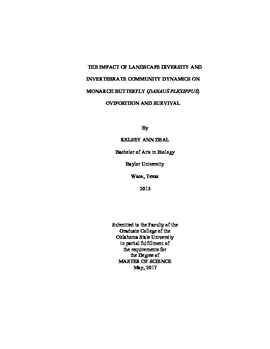| dc.contributor.advisor | Baum, Kristen A. | |
| dc.contributor.author | Deal, Kelsey Ann | |
| dc.date.accessioned | 2018-03-13T18:15:34Z | |
| dc.date.available | 2018-03-13T18:15:34Z | |
| dc.date.issued | 2017-05-01 | |
| dc.identifier.uri | https://hdl.handle.net/11244/54515 | |
| dc.description.abstract | The monarch butterfly (Danaus plexippus) eastern migratory population has experienced declines due to several factors including habitat loss. Monarchs rely exclusively on milkweeds as a host plant and conservation efforts are interested in increasing habitat resources by planting milkweed in towns and cities. Therefore it is important to identify factors that influence monarch use of and success (i.e., survival) in urban areas. I evaluated three monarch response variables to assess monarch fecundity and survival at multiple life stages. Monarch egg abundance, egg to 4th and 5th instar survival, and 4th and 5th instar to adult survival were compared to three categories of predictor variables: plant characteristics, invertebrate community dynamics, and landscape context. I established experimental plots at garden sites around Stillwater, Oklahoma by planting three tropical milkweed (Asclepias curassavica) plants at each location. Landscape characteristics for each site were quantified using the Oklahoma Ecosystem Mapping Project. Plant characteristics and invertebrate community variables such as predator species richness, aphid density, and percent herbivory were estimated by monitoring study sites during the fall (mid-August through October) of 2015 and 2016. To quantify survival rates, 4th and 5th instar monarch caterpillars were collected from study sites and reared individually in the lab. Plant height was the only variable that significantly influenced egg abundance with a positive correlation between the average maximum plant height and the total number of eggs at a site. Egg to 4th and 5th instar survival was positively influenced by predator species richness and patch richness density but negatively influenced by plant height, aphid density, and percent herbivory. Lastly, 4th and 5th instar survival was positively influenced by predator species richness and negatively influenced by aphid density. Examining how additional landscape characteristics and community interactions influence monarch oviposition and survival will provide insights into the contribution of urban areas to support the monarch population, with important implications for urban wildlife ecology and conservation. | |
| dc.format | application/pdf | |
| dc.language | en_US | |
| dc.rights | Copyright is held by the author who has granted the Oklahoma State University Library the non-exclusive right to share this material in its institutional repository. Contact Digital Library Services at lib-dls@okstate.edu or 405-744-9161 for the permission policy on the use, reproduction or distribution of this material. | |
| dc.title | Impact of Landscape Diversity and Invertebrate Community Dynamics on Monarch Butterfly (Danaus Plexippus) Oviposition and Survival | |
| dc.contributor.committeeMember | Frazier, Amy E. | |
| dc.contributor.committeeMember | Rebek, Eric J. | |
| osu.filename | Deal_okstate_0664M_15219.pdf | |
| osu.accesstype | Open Access | |
| dc.description.department | Zoology | |
| dc.type.genre | Thesis | |
| dc.type.material | text | |
